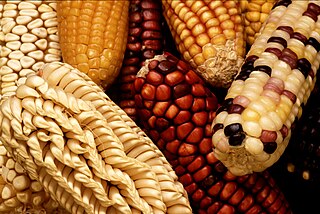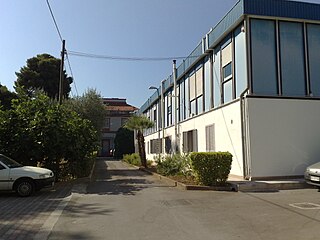
A seed bank stores seeds to preserve genetic diversity; hence it is a type of gene bank. There are many reasons to store seeds. One is to preserve the genes that plant breeders need to increase yield, disease resistance, drought tolerance, nutritional quality, taste, etc. of crops. Another is to forestall loss of genetic diversity in rare or imperiled plant species in an effort to conserve biodiversity ex situ. Many plants that were used centuries ago by humans are used less frequently now; seed banks offer a way to preserve that historical and cultural value. Collections of seeds stored at constant low temperature and low moisture are guarded against loss of genetic resources that are otherwise maintained in situ or in field collections. These alternative "living" collections can be damaged by natural disasters, outbreaks of disease, or war. Seed banks are considered seed libraries, containing valuable information about evolved strategies to combat plant stress, and can be used to create genetically modified versions of existing seeds. The work of seed banks often span decades and even centuries. Most seed banks are publicly funded and seeds are usually available for research that benefits the public.

Ex situ conservation is the process of protecting an endangered species, variety or breed, of plant or animal outside its natural habitat. For example, by removing part of the population from a threatened habitat and placing it in a new location, an artificial environment which is similar to the natural habitat of the respective animal and within the care of humans, such as a zoological park or wildlife sanctuary. The degree to which humans control or modify the natural dynamics of the managed population varies widely, and this may include alteration of living environments, reproductive patterns, access to resources, and protection from predation and mortality.
In situ conservation is the on-site conservation or the conservation of genetic resources in natural populations of plant or animal species, such as forest genetic resources in natural populations of tree species. This process protects the inhabitants and ensures the sustainability of the environment and ecosystem.

Agricultural biodiversity or agrobiodiversity is a subset of general biodiversity pertaining to agriculture. It can be defined as "the variety and variability of animals, plants and micro-organisms at the genetic, species and ecosystem levels that sustain the ecosystem structures, functions and processes in and around production systems, and that provide food and non-food agricultural products.” It is managed by farmers, pastoralists, fishers and forest dwellers, agrobiodiversity provides stability, adaptability and resilience and constitutes a key element of the livelihood strategies of rural communities throughout the world. Agrobiodiversity is central to sustainable food systems and sustainable diets. The use of agricultural biodiversity can contribute to food security, nutrition security, and livelihood security, and it is critical for climate adaptation and climate mitigation.

Gene banks are a type of biorepository that preserves genetic material. For plants, this is done by in vitro storage, freezing cuttings from the plant, or stocking the seeds. For animals, this is done by the freezing of sperm and eggs in zoological freezers until further need. With corals, fragments are taken and stored in water tanks under controlled conditions. Genetic material in a 'gene bank' is preserved in a variety of ways, such as freezing at -196 °C in liquid nitrogen, being placed in artificial ecosystems, or put in controlled nutrient media.
Germplasm Resources Information Network or GRIN is an online USDA National Genetic Resources Program software project to comprehensively manage the computer database for the holdings of all plant germplasm collected by the National Plant Germplasm System.
Genetic erosion is a process where the limited gene pool of an endangered species diminishes even more when reproductive individuals die off before reproducing with others in their endangered low population. The term is sometimes used in a narrow sense, such as when describing the loss of particular alleles or genes, as well as being used more broadly, as when referring to the loss of a phenotype or whole species.

Bioversity International is a global research-for-development organization that delivers scientific evidence, management practices and policy options to use and safeguard agricultural biodiversity to attain global food- and nutrition security, working with partners in low-income countries in different regions where agricultural biodiversity can contribute to improved nutrition, resilience, productivity and climate change adaptation.

A crop wild relative (CWR) is a wild plant closely related to a domesticated plant. It may be a wild ancestor of the domesticated (cultivated) plant or another closely related taxon.
Crop diversity or crop biodiversity is the variety and variability of crops, plants used in agriculture, including their genetic and phenotypic characteristics. It is a subset of a specific element of agricultural biodiversity. Over the past 50 years, there has been a major decline in two components of crop diversity; genetic diversity within each crop and the number of species commonly grown.

Istituto di Genetica Vegetale (IGV) is a research network om Plant Genetics and Breeding within the Italian Consiglio Nazionale delle Ricerche. IGV is headquartered in Bari and has four different Divisions in Portici, Palermo, Florence and Perugia. IGV started its activities in November 2002.

Aframomum corrorima is a species of flowering plant in the ginger family, Zingiberaceae. It's a herbaceous perennial that produces leafy stems 1–2 meters tall from rhizomatous roots. The alternately-arranged leaves are dark green, 10–30 cm long and 2.5–6 cm across, elliptical to oblong in shape. Pink flowers are borne near the ground and give way to red, fleshy fruits containing shiny brown seeds, which are typically 3–5 mm in diameter.
The U.S. National Plant Germplasm System (NPGS) is a network of institutions and agencies led by the Agricultural Research Service (ARS) of the U.S. Department of Agriculture in the effort to conserve and facilitate the use of the genetic diversity of agriculturally important plants and their wild relatives.
Genesys is an online, global portal about plant genetic resources for food and agriculture. It is a gateway from which germplasm accessions from gene banks around the world can be easily found and ordered.
The Nordic Genetic Resource Center is a plant, farm animal and forest conservation, gene resource guardian, and sustainable use organization under and primarily financed by the Nordic Council of Ministers, and is headquartered in Alnarp, near Malmö, in southern Sweden. NordGen's primary mission is "securing the broad diversity of genetic resources linked to food and agriculture" through "conservation and sustainable use, solid documentation and information work and international agreements".

Cryoconservation of animal genetic resources is a strategy wherein samples of animal genetic materials are preserved cryogenically.

Plant genetic resources describe the variability within plants that comes from human and natural selection over millennia. Their intrinsic value mainly concerns agricultural crops.
MusaNet is a global network of scientists and other stakeholders working on banana genetic resources. Founded in 2011 and coordinated by Bioversity International, it has over 100 individual members representing various banana research institutes and organizations.
Genetic resources means genetic material of actual or potential value where genetic material means any material of plant, animal, microbial or other origin containing functional units of heredity... Genetic resources thus refer to the part of genetic diversity that has or could have practical use, such as in plant breeding. The term was introduced by Otto Frankel and Erna Bennett for a technical conference on the exploration, utilization and conservation of plant genetic resources, organized by the Food and Agriculture Organisation (FAO) and the International Biological Program (IBP), held in Rome, Italy, 18–26 September 1967.
Plant cryopreservation is a genetic resource conservation strategy that allows plant material, such as seeds, pollen, shoot tips or dormant buds to be stored indefinitely in liquid nitrogen. After thawing, these genetic resources can be regenerated into plants and used on the field. While this cryopreservation conservation strategy can be used on all plants, it is often only used under certain circumstances: 1) crops with recalcitrant seeds e.g. avocado, coconut 2) seedless crops such as cultivated banana and plantains or 3) crops that are clonally propagated such as cassava, sweet potato.










